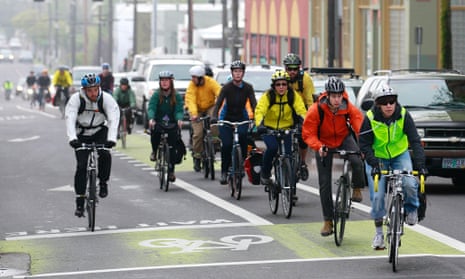Why don’t more women in the US bike? Men are two to four times more likely to make a bicycle trip than women, and just one quarter of bicycle commuters are women nationwide. The gap is large, and no city in the US has closed it.
Many researchers and advocates chalk it up to differences in risk and comfort.
Women are more risk averse than men, the theory goes, and women need better infrastructure to feel comfortable riding. Cycling data from here and abroad seem to support this theory, with the most dramatic example found in the Netherlands.
Dutch cities are equipped with networks of separated bicycle paths, and as a result they actually have more women cyclists than men. One of the most bikeable cities in the US is Portland, Oregon, which also seems to fit the pattern: it has great bike infrastructure, and one in three bicycle commuters are women. This isn’t parity, but it’s as close as any US city has come.
Yet recent research at UCLA (by one of us, Kelcie Ralph) shows that the infrastructure explanation leaves out a major piece of the puzzle. In short, despite years of progress, American women’s lives are still disproportionately filled with driving children around, getting groceries, and doing other household chores – housework that doesn’t lend itself easily to two-wheeled transportation. It turns out that women may be more likely to bike in the Netherlands because Dutch culture is giving them more time to do so.
According to the UCLA report, women with children make twice as many child– serving trips and nearly twice as many grocery trips as their male spouses. Even when women earn more, are better educated, and work more hours than their male partners, they still make 1.5 times as many child-serving trips and 1.4 times as many grocery trips. These findings reflect the fact that in most US families women still shoulder the responsibility for caring for the household, and that responsibility is hard to manage on a bike.
Dutch women can use bikes to get around because they are less pressed for time than American women, in three fundamental ways. First, thanks to family-friendly labour policies like flexitime and paternity leave, Dutch families divide childcare responsibilities much more evenly than American families. Second, work weeks in the Netherlands are shorter. One in three Dutch men and most Dutch women work part-time, and workers of either gender work fewer hours than Americans.
Lastly, Dutch parents do much less chauffeuring of children and elderly family members than American parents. Neighbourhood schools and high-quality bike infrastructure in the Netherlands make it easy for Dutch kids to walk or bike to school, unlike their counterparts in America, where rates of bicycling and walking to school have been declining for decades. Dutch elderly are also much more independently mobile than their American counterparts.
If American cities hope to improve mobility by ushering in a European-style bike renaissance, improving bike infrastructure and promoting cycling will be necessary, but it probably will not be enough. The lack of women on bikes is a symptom of much deeper societal differences that, sooner or later, American urban planners will need to confront. Here are three policy changes that could help shift the culture.
First, reduce the burden of housework — and its associated trips — on women. Family-friendly policies such as paid paternity leave make it possible for men to help at home, and they set the pattern for the rest of parenthood.
Second, step back from our “always-there” work culture, and also pay workers a living wage. Reducing total work hours and encouraging more flexible schedules for men and women alike could free up the time necessary to get around by bike. And imagine what a game-changer it would be if low-income women could work one decently paid job rather than two or three, or if high-income women weren’t expected to be at the office 60-plus hours a week.
Finally, design communities that everyone — children, parents and grandparents alike — can navigate safely without a car. Local schools, safe streets and easily accessible activities help encourage independent mobility, and reduce the expectation that women need to serve as family chauffeurs.
Admittedly, these ideas have far-reaching implications and require serious value shifts, but there’s no reason that bicycle advocates and planners shouldn’t be part of that discussion.
To build sustainable transportation networks that work for everyone, policymakers will need to go beyond what they see on the street itself. They’ll have to look into the Dutch home where a husband is changing a diaper on paternity leave; into the Dutch workplace where a mom on a flexible schedule can leave before the sun goes down; and into Dutch schools where children receive universal education about how to ride a bike to school, freeing up their parents to ride to work.

Comments (…)
Sign in or create your Guardian account to join the discussion